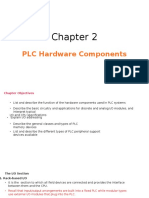0% found this document useful (0 votes)
35 views50 pagesLecture 4
The document provides an overview of discrete input/output (I/O) systems, detailing their role in connecting CPUs to field devices and the functioning of digital signals. It explains the structure and mapping of I/O rack enclosures, the types of input/output modules, and their functions, including termination, signal conditioning, isolation, and indication. Additionally, it covers various types of discrete inputs and outputs, including AC/DC inputs, TTL inputs, and the operation of output interface circuitry.
Uploaded by
malnahamCopyright
© © All Rights Reserved
We take content rights seriously. If you suspect this is your content, claim it here.
Available Formats
Download as PDF, TXT or read online on Scribd
0% found this document useful (0 votes)
35 views50 pagesLecture 4
The document provides an overview of discrete input/output (I/O) systems, detailing their role in connecting CPUs to field devices and the functioning of digital signals. It explains the structure and mapping of I/O rack enclosures, the types of input/output modules, and their functions, including termination, signal conditioning, isolation, and indication. Additionally, it covers various types of discrete inputs and outputs, including AC/DC inputs, TTL inputs, and the operation of output interface circuitry.
Uploaded by
malnahamCopyright
© © All Rights Reserved
We take content rights seriously. If you suspect this is your content, claim it here.
Available Formats
Download as PDF, TXT or read online on Scribd
/ 50





























































































